Pyoderma in cats is a chronic skin infection which literally translates to “pus in the skin.” It can be a result of bacterial infections, parasitic infestation, inflammation, allergic reactions and/or cancer. In the most common cases, bacterial skin infections in cats are called pyoderma.
Signs of Bacterial Skin Infection in Cats
The clinical signs of pyoderma in cats are not as well-defined as in dogs.
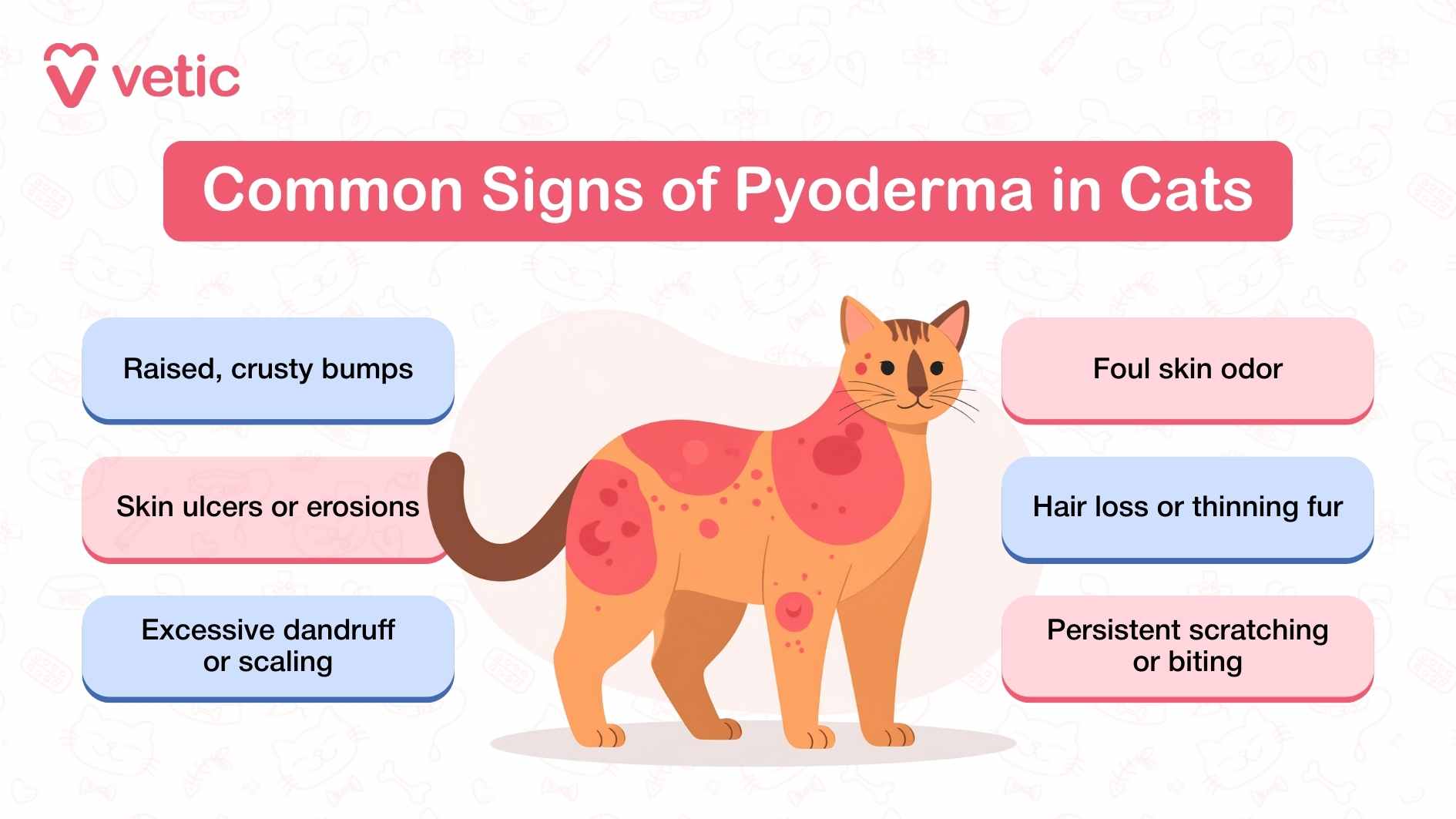
Signs of pyoderma in cats can include –
- Raised bumps with crusting and erosion
- Excessive scaling
- Ulcers with erosions
- Self-inflicted wounds (scratching/nibbling)
- Wounds from feline acne
- Non-healing wounds
- Hair loss
- Skin odor
The signs of pyoderma in cats typically do not include patchy hair loss or alopecia like in dogs.
What Causes Bacterial Skin Infections in Cats?
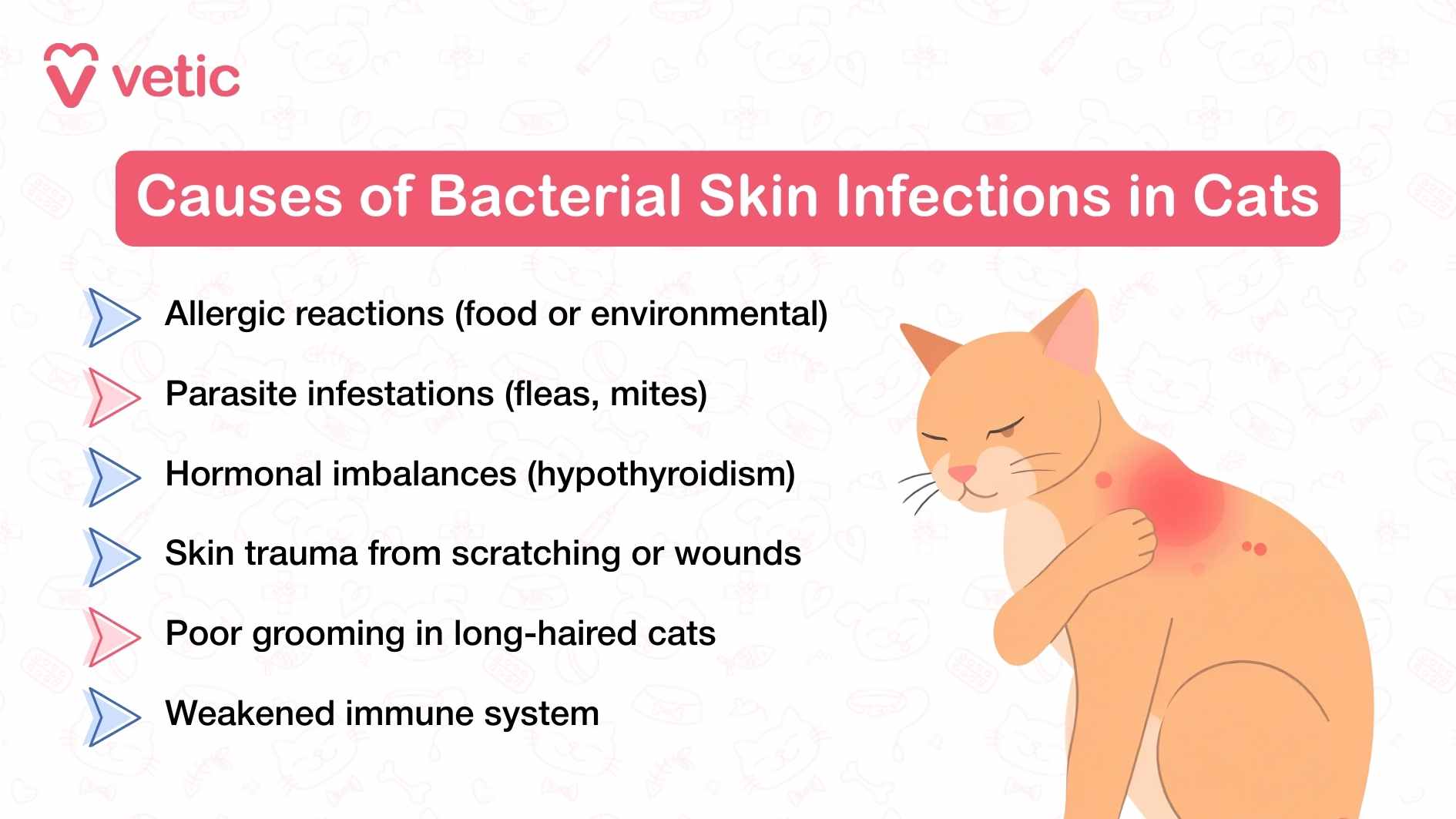
Bacterial pyoderma in cats is typically caused by the overgrowth of the normal skin microbiome. The most common pathogens causing bacterial skin infection (pyoderma) in cats are S. pseudintermedius, S. aureus, S. felis and Pasteurella multocida.
Superficial pyodermas develop in the warm and moist folds of the skin. That is why it’s more common in flat-faced cat breeds with several facial folds. A cat’s facial folds, neck folds, axillary areas, interdigital areas, elbows and tail folds have a higher risk of bacterial infection.
Types of Pyodermas in Cats

Pyodermas in cats can be complex or simple. The simple pyoderma infections typically begin with one-time events such as flea bites.
Complex infections can be recurrent and caused by multiple underlying conditions. The causes of complex bacterial pyoderma in cats can include –
- Allergic reactions
- Hormonal disorders (hypothyroidism or Cushing’s)
- Parasites (Demodex)
- Brachycephaly (skin fold)
- Immunodeficiency or immunosuppression
Bacterial pyodermas are typically limited to the upper layer of the skin and veterinarians often refer to them as superficial. The pyodermas that involve the inner layers of the skin are called deep.
The Proper Diagnosis of Bacterial Skin Infections in Cats
The proper diagnosis of bacterial skin infections in cats is mandatory for correct treatment. Since one or more bacteria can be involved in the infection, it is important to identify the causal organisms to understand which medicines will work the best for your cat.
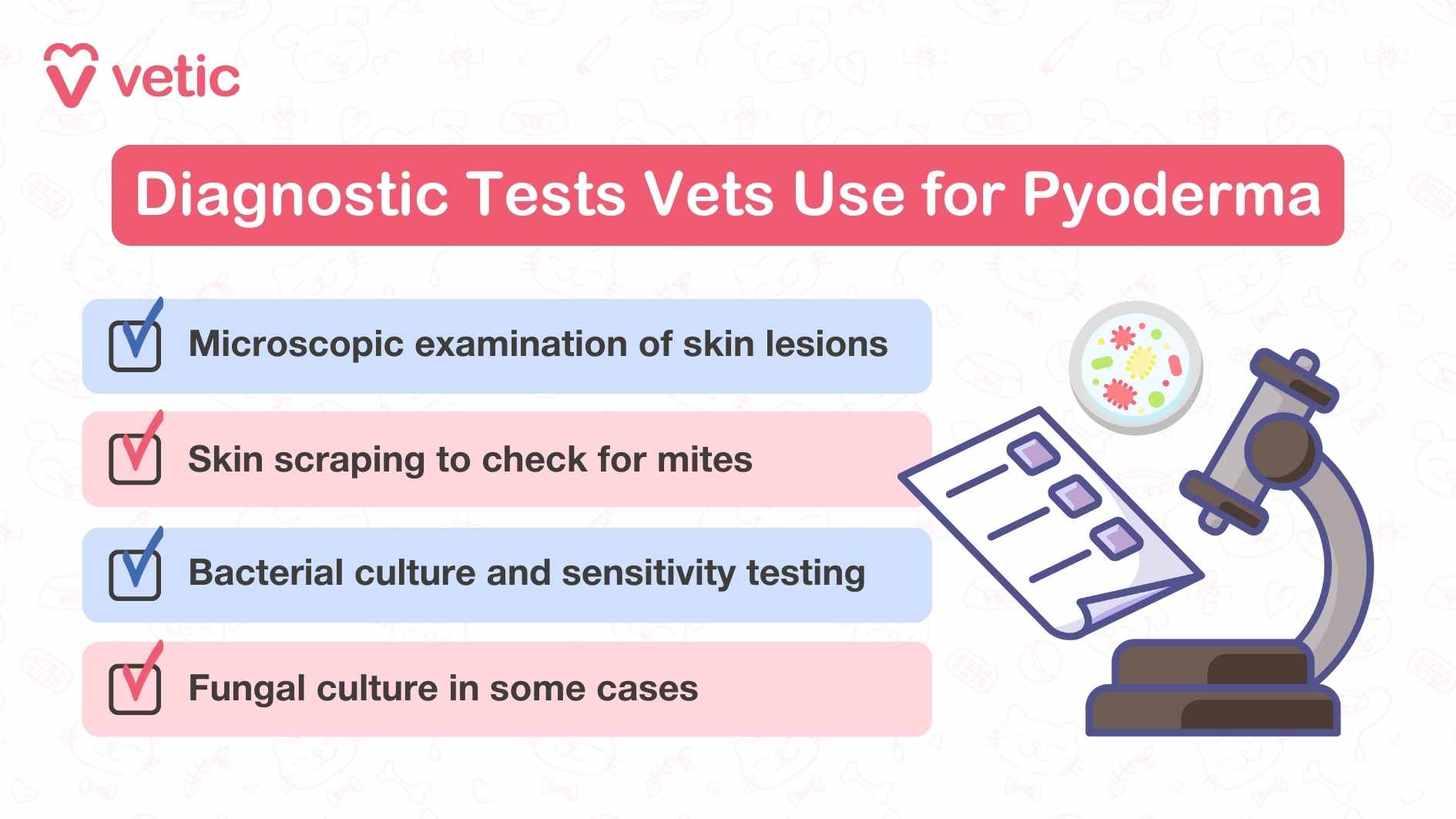
Now, diagnostic options veterinary dermatologists recommend are –
Microscopy/Cytology
The veterinarian will take samples from the skin lesions of your cat and study them under the microscope. That will reveal the presence (or absence) of bacteria, white blood cells or other agents.
Skin scraping
The veterinarian will gently scrape your cat’s skin from around the affected areas and look for mites. It can cause some irritation and mild bleeding.
Skin culture and sensitivity testing
It can help the vet determine the types of bacteria present and the antibiotics that will work for the same. Bacterial C&S is crucial to reduce antibiotic resistance and ensure your cat receives only the meds they need.
Fungal testing
In some cases, the doctor will also check for fungal growth via culture to diagnose the cat’s skin condition.
What are the Available Treatment For Bacterial Skin Infections in Cats?
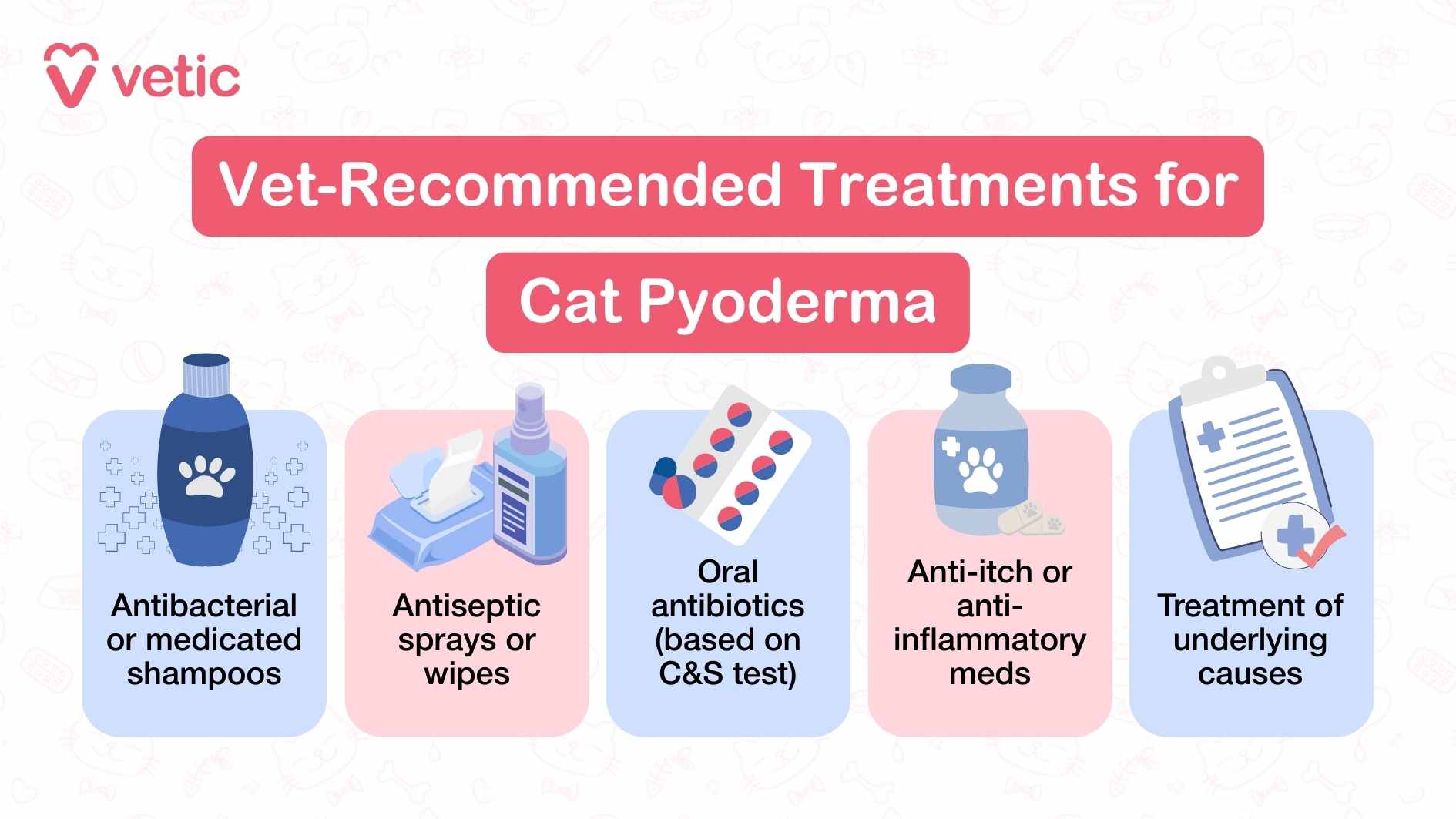
Topical Treatment for Pyoderma in Cats
Topical medications are available for bacterial skin infections in cats. However, you must ensure your cat doesn’t lick it after it’s applied. Here are the common topical treatments prescribed by veterinarians for pyoderma in cats –
- Antiseptic, antifungal and antibacterial shampoo
- Benzoyl peroxide shampoo
- Antiseptic & antifungal spray
- Antimicrobial pet wipes
These products are usually more effective in eliminating simple or superficial pyoderma.
Systemic Treatment for Pyoderma in Cats
Systemic or oral medication is required in the cases of deep pyoderma. Oral antibiotics are the most common course of treatment for bacterial skin infections in cats. The choice of antibiotics depends upon the bacterial culture and sensitivity, and your cat’s overall health.
In rare cases, antifungals may be prescribed in low doses. However, never begin a course of antibiotics or antifungals for cats on your own, without diagnostic testing.
What Should You Ask Your Vet About Your Cat’s Skin Infections?
If your cat has been diagnosed with pyoderma, it’s important to have a clear understanding of the treatment and recovery process. Here are a few essential questions you should ask your vet:
- What is causing the infection?
Understanding the root cause will help in managing the condition better. It could be allergies, parasites, or something more complex like a hormonal issue. - How long will the treatment last?
Ask your vet how many days or weeks your cat needs to be on antibiotics or other medication. Stopping treatment too early can cause the infection to come back. - What is the correct dose?
Confirm the exact dosage of antibiotics and how often you need to give them. Incorrect dosing can lead to resistance or side effects. - Are there easier alternatives available?
If your cat is difficult to medicate, ask about long-acting injectable antibiotics or flavored formulations that are easier to give at home.
Always follow your vet’s advice and complete the full course of treatment, even if the symptoms seem to get better early.
Recovery and Management of Bacterial Skin Infections in Cats
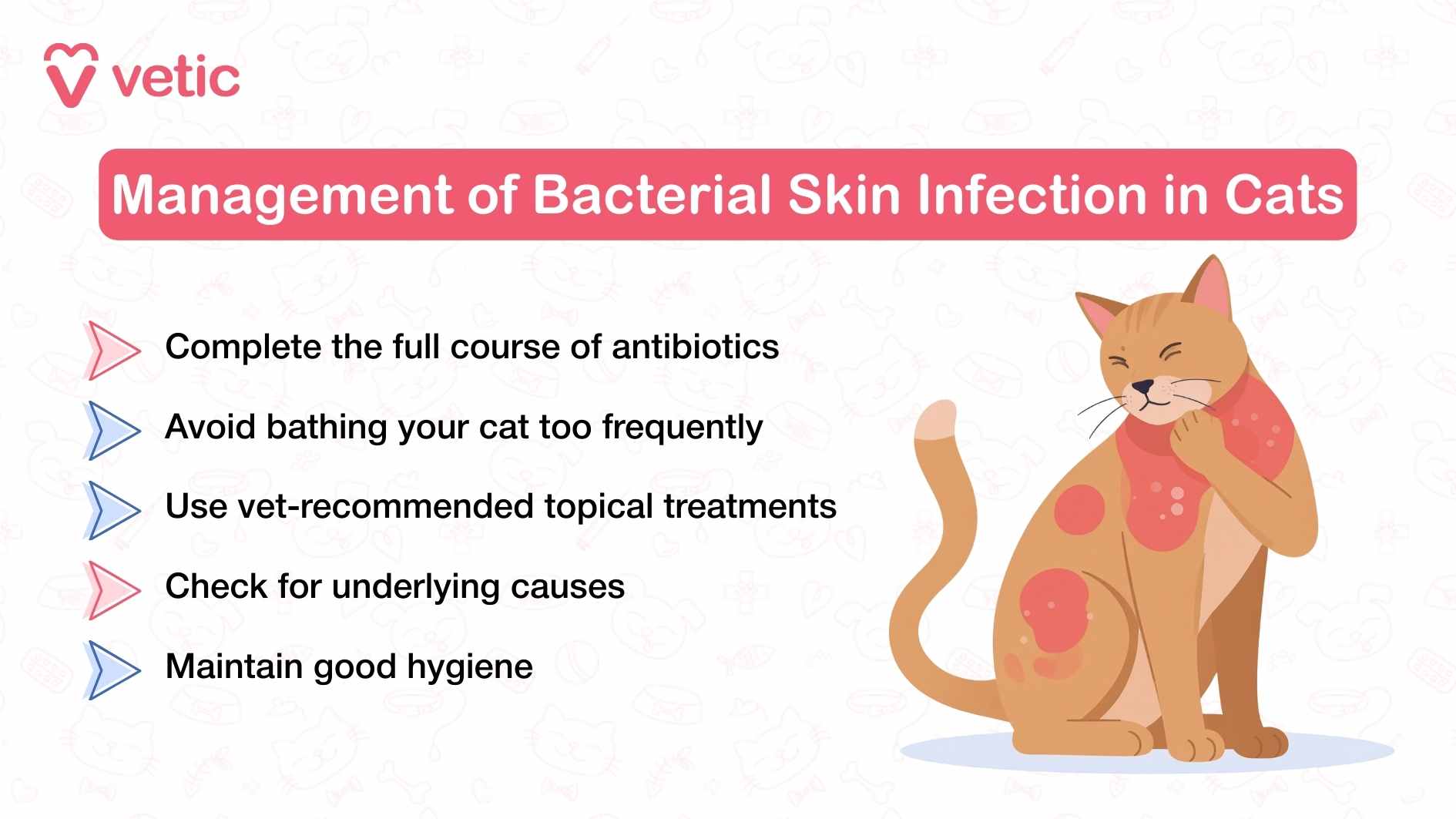
The recovery from pyoderma depends on the severity of the infection and your cat’s overall health. With proper treatment, most cats start to show improvement within a week. However, deep infections may take longer to heal completely.
Here are a few tips to support your cat’s recovery:
- Complete the full course of antibiotics as prescribed by your vet.
- Avoid bathing your cat too frequently unless directed by your vet. Overbathing can dry out the skin and slow healing.
- Use only vet-recommended topical treatments. Don’t apply human creams or ointments on your cat’s skin.
- Check for underlying causes like flea infestations, allergies, or hormonal issues to prevent recurrence.
- Maintain good hygiene by cleaning your cat’s bedding, grooming tools, and living space regularly.
In some cases, pyoderma may recur if the root cause is not treated. Regular checkups and skin assessments can help keep infections in check. If you notice new lesions or if your cat starts scratching again, visit your vet for a follow-up.
FAQs on Pyoderma in Cats
1. Is pyoderma in cats contagious to other pets or humans?
Pyoderma itself is not usually contagious. However, if caused by parasites or fungal infections, it may spread. Always follow your vet’s hygiene and treatment guidelines to protect other pets and family members.
2. Can cats get pyoderma from scratching too much?
Yes, constant scratching or licking due to allergies or parasites can break the skin barrier, allowing bacteria to enter and cause infection. Treating the underlying cause is key to preventing pyoderma.
3. How long does it take for a cat to recover from pyoderma?
Recovery can take 2 to 6 weeks depending on the depth of the infection and overall health. Superficial cases clear up faster than deep pyoderma. Always complete the prescribed course of treatment.
4. Can I treat pyoderma in my cat at home?
Home care supports recovery, but treatment should always be guided by a vet. Incorrect or delayed treatment can worsen the infection. Use only prescribed medications and follow your vet’s instructions carefully.
5. What breeds of cats are more prone to pyoderma?
Flat-faced (brachycephalic) breeds like Persians and Exotic Shorthairs are more prone due to skin folds that trap moisture. Regular cleaning and early vet intervention help prevent infections in these breeds.

